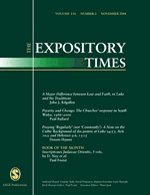The Filmgoer's Guide to God
 【本文原刊於Expository Times第116卷第2期(2004年11月)65-66頁,為慶祝該刊近日「重新啟航」(relaunch),及本文刊出一週年,經原作者同意,特此轉載。但未向出版社(Sage)及編輯申報,讀者請勿報串。】
【本文原刊於Expository Times第116卷第2期(2004年11月)65-66頁,為慶祝該刊近日「重新啟航」(relaunch),及本文刊出一週年,經原作者同意,特此轉載。但未向出版社(Sage)及編輯申報,讀者請勿報串。】
Book Review
The Filmgoer’s Guide to God. By
The year 2004 might for many be marked as a special year in which the interest in religious elements in the cinema is rekindled, due to worldwide release in spring of the film The Passion of the Christ directed by Mel Gibson. It is of course sheer coincidence that Cawkwell’s The Filmgoer’s Guide to God is published at the same time. The book is divided into thirteen chapters which discuss films according to classical Christian motifs such as ‘God’s Grace and God’s Silence’, ‘Faith’, ‘Salvation by Water’, ‘Crucifixion’, and ‘Resurrection’, etc. Under most chapter headings three to four films are discussed, except the chapter on crucifixion which concentrates exclusively on The Passion of Joan of Arc (directed by
The author claims that he aims to ‘give an introduction to religious cinema for those with a general interest in religious art and literature’ (p.2). While he covers quite a number of European films and some US American films, the book’s focus is on four filmmakers: Bresson, Dreyer,
The serious dialogue of theology / religion with the cinema has been going on for at least more than three decades and has become a rapidly growing area of study since the 1990s. But it seems that Cawkwell is either not aware of this trend or he is not interested in engaging with it at all. Notwithstanding his familiarity with film, Cawkwell’s discussions on the religious are far less substantial than his treatment on film. Hence, contrary to what its title intends to convey, his book might have a hard time guiding the filmgoer to God. Instead, this book might more suitably be titled as ‘The Churchgoer’s Guide to (
Yam Chi-Keung
A Google search by somebody from France has brought my attention to a review on the same book by another person, published in the Journal of Religion and Film 9.2 (October 2005) >> READ HERE <<








1 comment:
Got you.
Post a Comment